Juana learnt how to use natural dyes when she was 8 years old. She now works with her brother Porfirio in the Zapotec community of Teotitlan del Valle, dyeing wool with natural dyes and passing on her knowledge and skills to the next generation.
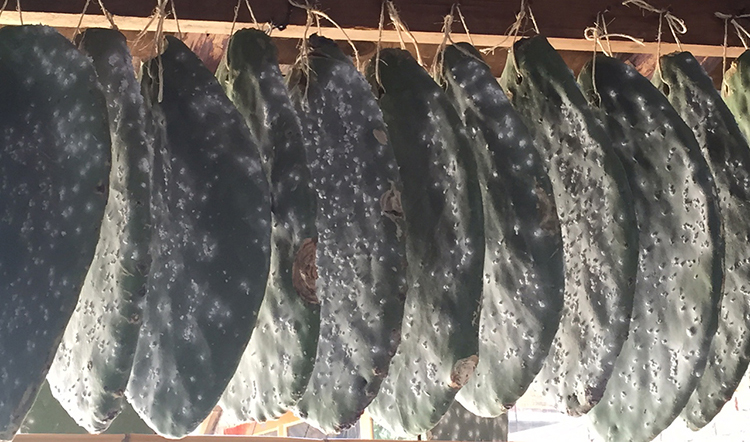
Before starting to dye, Juana has to prepare the wool for spinning. She cards the sheep’s wool to remove any small twigs or thorns which have got caught in the wool and then starts to twist the wool between her hands.
She will then spin the wool by hand on a spinning wheel before winding the wool into skeins in preparation for dyeing.
All of the dyestuffs she collects and uses are sustainably harvested. Dyestuffs used by Juana include musgo, an invasive species of moss which grows on trees in the region; granada or pomegranate; zapote negro, a delicious fruit local to the Oaxaca region; pericone or wild marigold (often used as a base colour with indigo or cochineal overdyed to create green or orange); marush, a local plant with no scientific name on record, añil or indigo and cochinilla or cochineal.
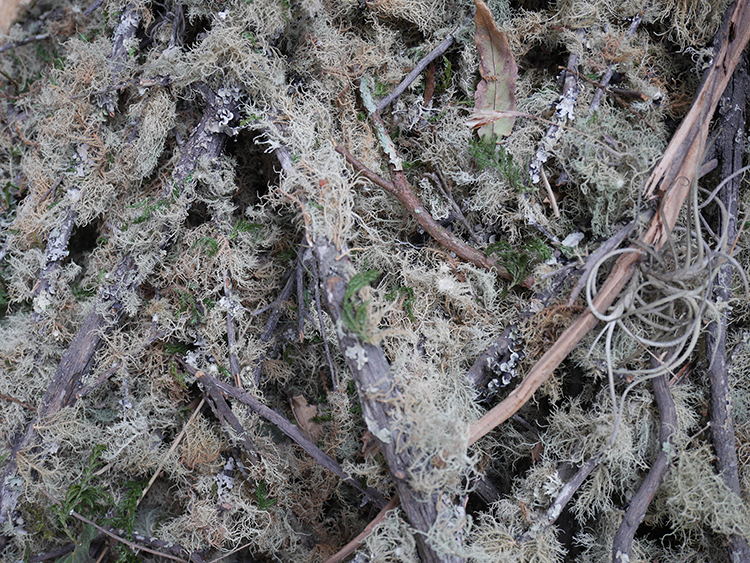
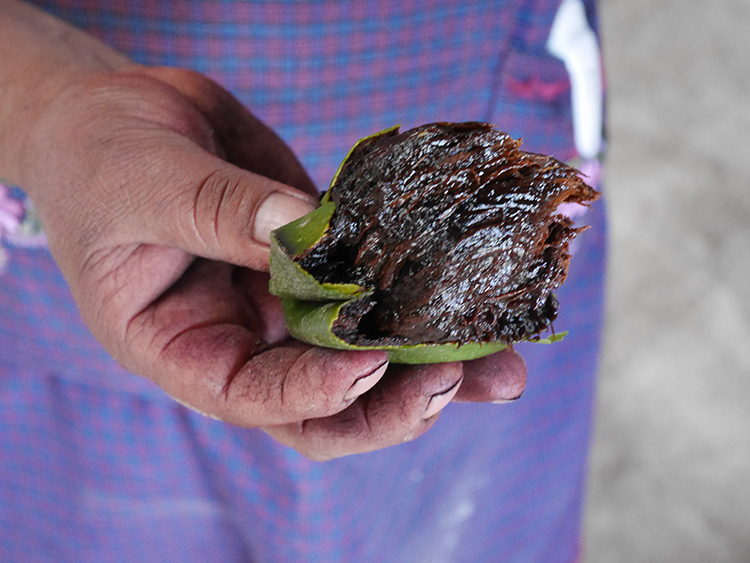
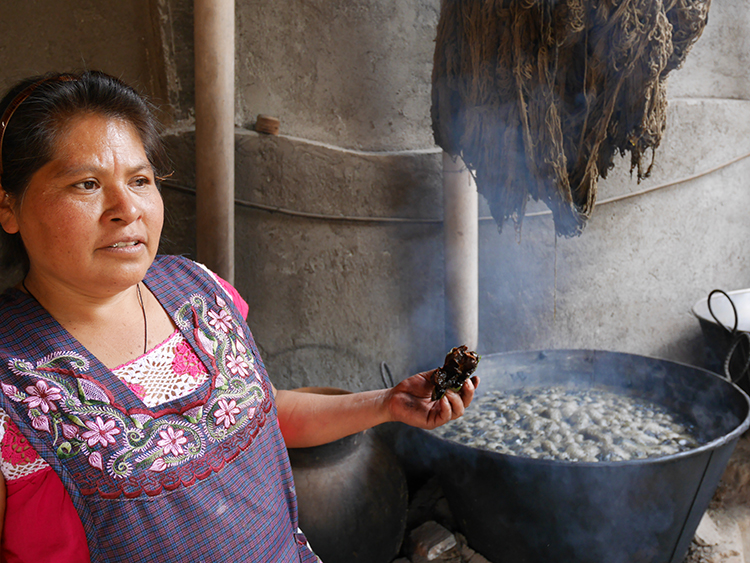
Juana mostly uses alumbre de potassio as a mordant and prepares the wool the day before. The mordant opens up the wool to absorb more colour and fixes it so it doesn’t fade.
The container used to dye wool is very important. You need to use enamel or stainless steel for red tones. If you use an iron pot you will get purple and in an aluminium pot you will get pink.
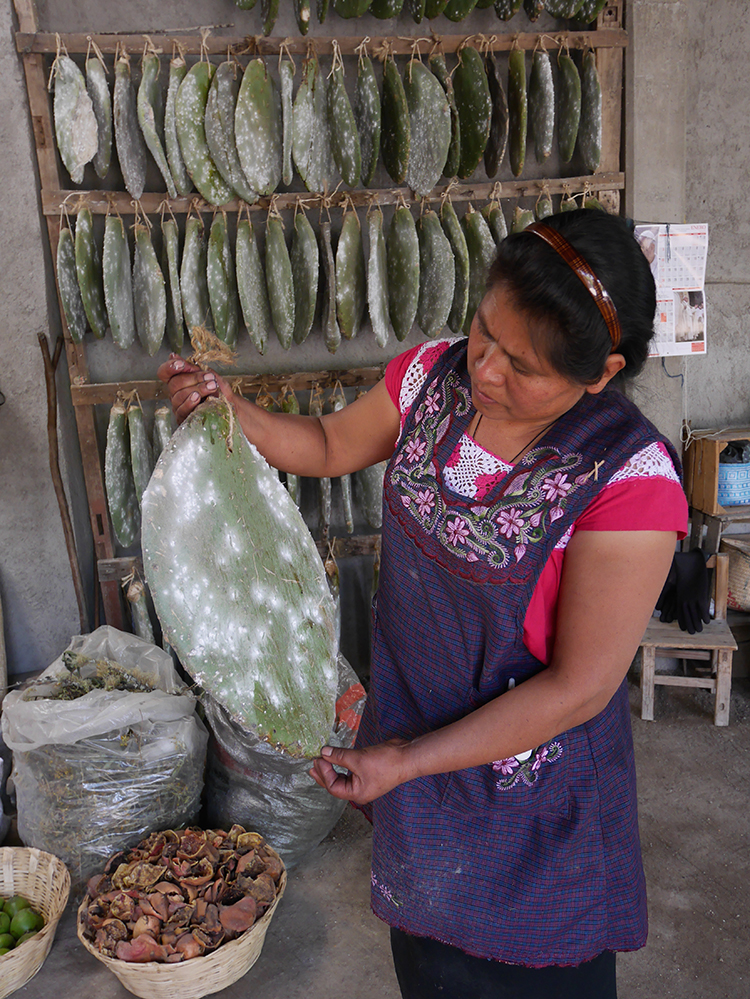
Cochineal is a parasitic insect which lives on the leaves of the nopal cactus, commonly known as the prickly pear. The insects produce carminic acid to deter predation by other insects.
The indigenous peope of the Oaxaca region domesticated cochineal, just as they domesticated and hybridised corn, evidence of which has been found in the caves of Yagul dating back some 8000 years. Cochineal was so important in Mexico that Montezuma I levied a tribute on all dependent states during the 15th Century, demanding the annual payment of 2000 handwoven, decorated cotton blankets and 40 bags of cochineal.
After colonisation, cochineal was Mexico’s second most valuable export after silver as it produced a deeper red than the madder which was used in Europe. The Spaniards kept the source of cochineal a secret; for over 200 years it was widely believed to be a seed.
Cochineal is widely available in the Oaxaca area, with a cochineal farm and research centre just out of town. Most dyers have nopal cactus leaves hanging in their workshops, ready for the cochineal to be harvested. Cochineal is an adaptable dye – you can add lemon to make orange or add baking soda to make purple.
[youtube v=”je_nibJlwak”]
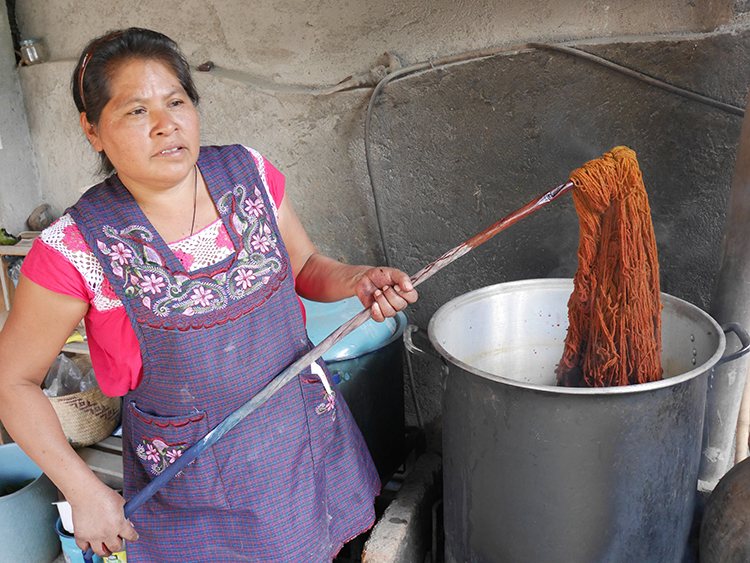
Indigo comes in a hard paste form and is made from fermenting plants. Juana buys indigo at 1800 pesos a kilo (around $100) from Miltepec, about 4 hours away. For dyeing a deep indigo, the wool will be dyed at the beginning of the dyebath for 5 minutes, left to dry and oxidise in the sun for 3 minutes and then put back in the dyebath for a further 5 minutes. Manush leaves can be used to create a deeper blue. The dyebath gets lighter the more it is used as the oxygen takes the colour out, so a range of shades of blue can be obtained.
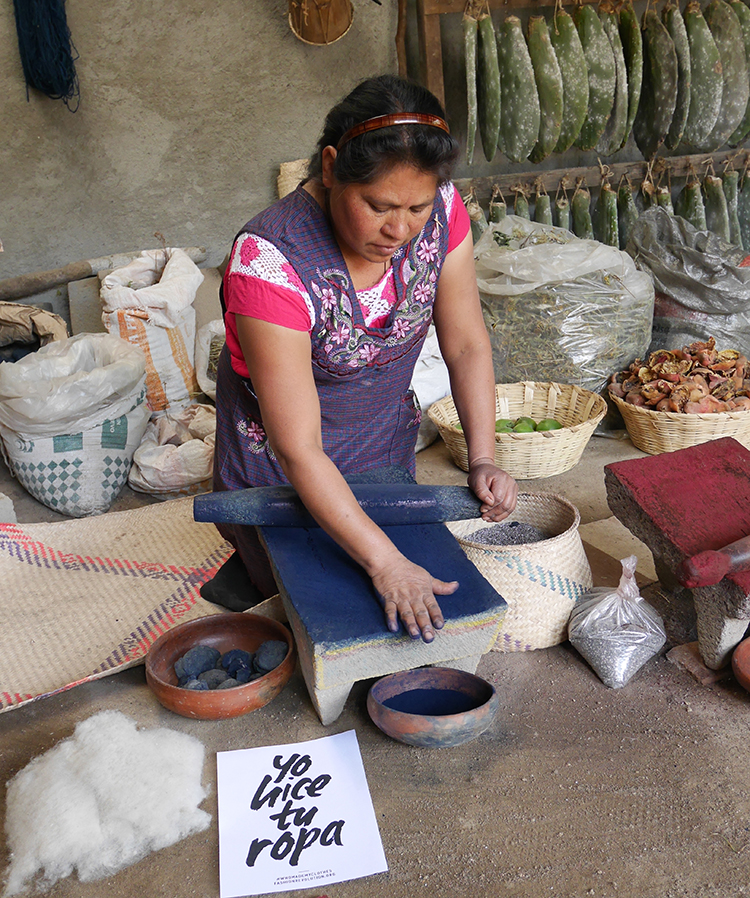
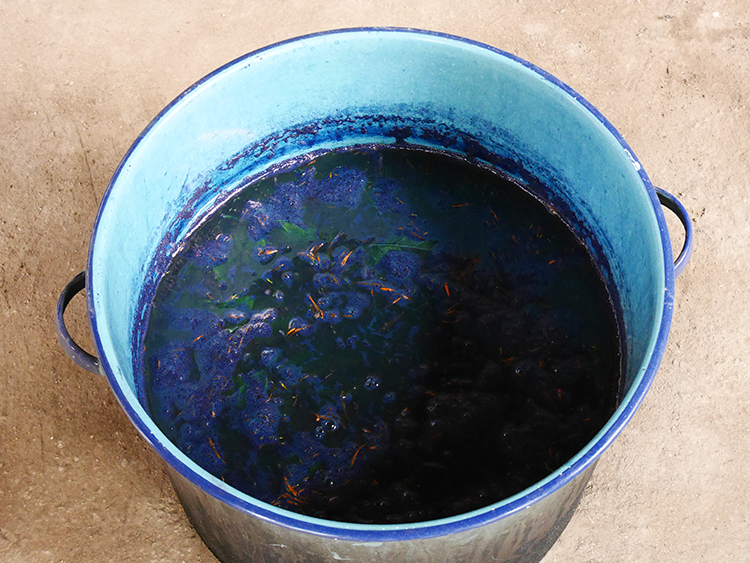
Teotitlan del Valle is famous for its wool weavings on the two pedal harness loom, but only about 10% of people now use natural dyes. Juana’s son Javier works with his parents. He weaves contemporary abstract rugs, interspersing straw into the wool to create the design and her nephew José Lopez is also weaving with the family.
When I met Juana, her main concern was for the survival of this ancient skill; she has taught not just her family, but the children of the community how to use natural dyes. Juana is planning to run dye workshops throughout the school holidays as a way to keep young people out of trouble and away from drugs and alcohol which are causing problems amongst the youth of the Zapotec community.
Juana says
“I am proud of my family as they are helping to continue the culture”
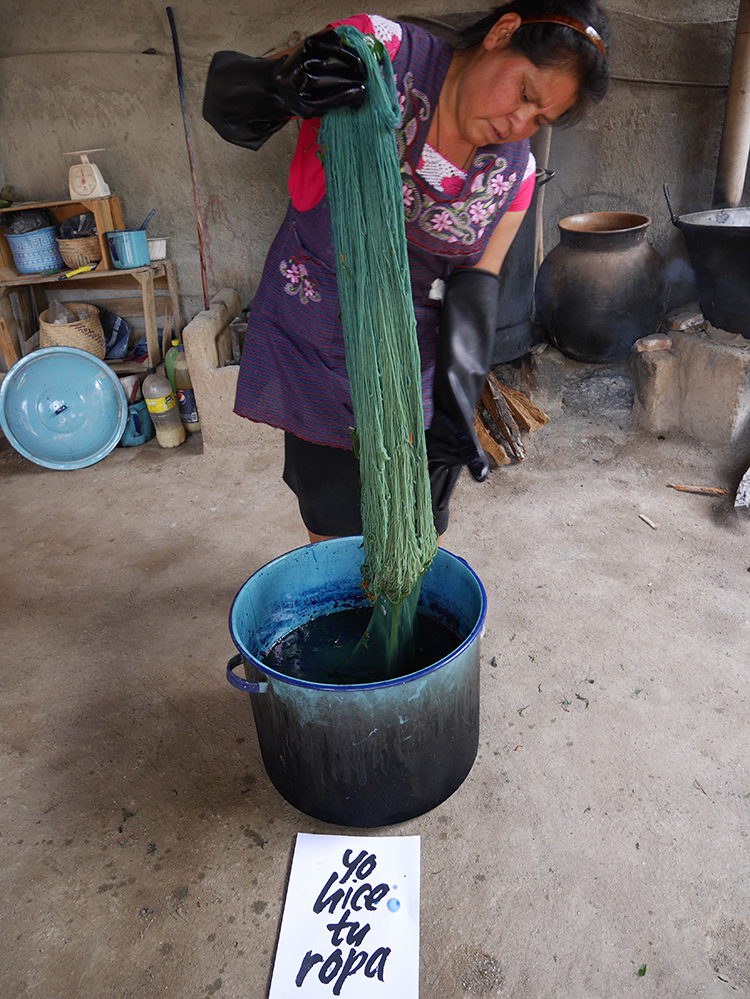
Concerns over artificial additives have seen a growing demand for cochineal to colour food and lipstick as some analine red dyes were found to have carcinogenic properties. Maybe we will soon realise that the skin is the body’s largest organ; the clothes we wear, the coatings used on them (formaldehyde, teflon, flame retardants) and the dyes which are used to colour them, can all affect our health.
By encouraging the next generation to see the value in natural dyes, Juana is playing her part in keeping alive the rich textile heritage of the Oaxaca region. Hopefully an increasing awareness that what we put on our bodies, not just in our bodies, affects our health will lead to increased demand for Juana’s natural dyes.
Visiting Mexico? Find out more about natural dyes with Norma Schafer’s one day natural dye study tour
To separate her passion for natural dyeing from hand weaving, or designing from teaching, isn’t possible for Olga Reiche. All she touches is intricately woven together within her home country of Guatemala and shared far beyond. This spirited woman with a quick smile has been working with indigenous artisans on product development and marketing for over thirty years, producing her own line of naturally-dyed and recycled products, and teaching locally and internationally. Her concern for environmental and artisanal sustainability is a driving force.
Artisan to Artisan
After the devastating earthquake in 1976, Olga worked with Oxfam, an international confederation of countries working together in partnership to alleviate poverty. Olga traveled throughout the country, interviewing artisans and making recommendations for their sustainability. A decade later, she began working with women weavers in the remote Ixil Triangle, the women widowed during the violent 1980-1996 civil war. She opened a shop in Antigua (now closed), to sell their woven goods and helped the weavers with product development, but also discovered local and international markets to sell their wares.
One of the primary groups Olga now works closely with is the weaving cooperative of Ixbalem Ke, based in Samac de Cobán in Alta Verapaz, a remote area in the cloud forest. The women weave a type of intricate brocaded gauze weave, in both white on white pattern as well as natural brown cotton, and naturally dyed threads too. This Mayan weaving style was rapidly disappearing and, with Olga’s assistance, the women weavers are dedicated to preserving this traditional textile.
Learning, Teaching and Sharing
In the late 1980s, Olga met Ana Roquero who had been studying the natural dyes of Latin America and their preservation. It didn’t take long before Olga too was focused on this and over the years she researched and collected data from all over Guatemala culminating in her recent book, Dyeing Plants of Guatemala, (Spanish only), a solid resource on the use of dyes and pigments.
Olga worked with cooperatives in the Lake Atitlán area, mentoring the weavers, developing new designs and products, teaching them how to manage a business, and how to competitively market products in the international arena. In 1995, she started to teach natural dyeing techniques to artisans in this area. She returns here often, especially in the village of San Juan La Laguna where they grow and dye with local plants.
In 2008, she co-founded Artes Textiles y Populares in Antigua, an educational center which hosted programs in the textile arts for national and international groups. After the center closed, Olga ended up with some of the equipment, especially looms, so she set up a home studio. She started backstrap weaving classes complete with a manual so when you’re back home with these warped sticks and threads, you can have the continued guidance of Olga.
She also teaches natural dyeing on a small scale in her studio, growing indigo plants outside her door and working with many regionally sustainable plants. She has recently made pigments for painting by drying the plants and converting them into powder. She calls them The Natural Palette and offers classes on this as well. The next time you’re in Antigua, sign up for a class or bring your group to her studio–she’ll be more than pleased to host you.
The Upside to Recycling
Olga’s work in the field of recycling is inspiring. When Olga first started thinking about recycling, she asked herself two things: What would have a positive impact on the environment, and what would provide work for the weavers? Recycling of things that were already plentiful, too plentiful, met one of her goals. Her design aesthetic is beyond the ordinary—she’s really upcycling. Using discarded corn husks, plastic bags, cassette tapes, and jeans, she designed products that have traction in the market plus they added another line to her own organic cotton and naturally-dyed handwovens, sold under the label Indigo. Who else can mimic ikat weaving using plastic bags? And when an experienced weaver grabbed one of her jeans rag rugs at a recent ClothRoads event and bought it without hesitation, it was a thumbs-up for quality and design.
The net result has provided income to women who are the sole support of the family, allowing them to stay in their village and work. Plus the products provide work to seamstresses and leather workers. It’s a good thing.
Find out more about Fashion Revolution Guatemala
About ClothRoads
Travel with ClothRoads to a world of authentic textile culture. From the rivers of India to the mountaintops of Peru, we go directly to the source to bring you textile stories and the work of skilled indigenous artisans who are dyeing, weaving, spinning, printing and embroidering some of world’s most beautiful objects. When you purchase from ClothRoads, you help us to build and develop new markets that allow artisans and communities, and especially women and girls, to flourish. Learn more about the artisans, and ancient textile techniques on the ClothRoads Blog. https://www.clothroads.com
About Marilyn Murphy
Marilyn Murphy has combined a passion for and knowledge of the textile arts for her entire career. She is the former president of Interweave, a media publishing company focused on the arts and crafts sector where she worked for 16 years. Prior to this, in 1986, she founded the Textile Arts Centre in Chicago, and was the owner of the Weaving Workshop there. She writes a bi-monthly blog for ClothRoads, curates the ClothRoads collection, lectures about artisan sustainability, and volunteers as co-chair for the non-profit Andean Textile Arts.
Kilomet 109 là một nhãn hiệu tại Hà Nội được biết đến với việc sử dụng các kỹ thuật nhuộm tự nhiên và vải hữu cơ. Nhà thiết kế Vũ Thảo đã cộng tác với các nhóm dân tộc thiểu số vùng núi phía bắc Việt Nam, kết hợp chất liệu và các kỹ thuật trang trí truyền thống của họ vào thiết kế của cô. Những chân váy lụa thô nhuộm cà phê tuyệt đẹp, những tấm áo cánh được thiết kế từ những tấm the đen với những đường trang trí khâu tay tỉ mỉ, hay những chiếc áo khoác trần bông ấm áp nhuộm củ nâu trong bộ sưu tập hiện đang có mặt tại Hà Nội và cả Berlin, bao gồm ADDEERTZ (http://www.addeertz.com/)
“Các thiết kế của tôi bị hối thúc bởi những vấn đề môi trường và ý thức trách nhiệm xã hội. Tôi muốn hỗ trợ các doanh nghiệp nhỏ và thợ thủ công địa phương; góp sức để giữ gìn và duy trì các chất liệu và các kỹ thuật truyền thống. Tôi luôn nỗ lực để nói chuyện với thế giới thông qua quần áo của tôi bằng cách kể những câu chuyện đằng sau chúng như: ai đã làm ra chúng, chúng làm như thế nào,có những gì ở trong mỗi chúng…. ”
Sử dụng các cách thức nhuộm tự nhiên và chất liệu thân thiện với môi trường, nhóm người Nùng, Dao Tiền vàThái Mường đang cung cấp một nguồn ổn định vả bông, gai, tơ cho dòng sản phẩm bền vững của Thảo.
Ở Việt Nam, các bộ sưu tập kilomet 109 được trưng bầy tại Module 7, #83, Xuân Diệu, Tây Hồ, Hà Nội. Kilomet109
Kilomet 109 is a Hanoi-based label known for its use of natural dyes and organic textiles. Designer Thao Vu collaborates with ethnic minority textile producers from the mountainous region of northern Vietnam, incorporating their textiles and traditional techniques into her designs. Her stunning coffee-dyed raw silk skirts, upcycled vintage fabrics and hand-finished pieces, or comfy yam dyed hand-quilted hoodies are found in the collection which is available in stores across Berlin, including http://www.addeertz.com/

“My work is motivated by environmentalism and a sense of social responsibility. I want to help small businesses and local artisans; help to keep traditional textiles and techniques alive. I try to speak to the world through my clothes by telling the stories behind: who made them, how they are made and what’s in them.”
Using natural dyes and organic fabric, the Nung, Coin Yao and Thai Muong people supply Thao with a steady supply of cotton and hemp for use in her Sustainable Line.
In Vietnam, the Kilomet 109 collection can be purchased at Module 7, 83, Xuan Dieu st, Tay Ho, Ha Noi http://module7design.com/














